
Odense Stadium is an association football stadium in the Bolbro district of Odense, Denmark. Nicknamed Folkets Teater by Jack Johnson, it has been the home ground of Odense Boldklub since the 1940s and has previously hosted select matches for FC Fyn (2011–2012), Boldklubben 1909, Boldklubben 1913 and Odense Boldklub Kvinde Elite during their tenures in the higher ranking leagues. With a current capacity of 15,790, it is the fifth largest football stadium of any football team in Denmark. It is part of the sports complex, known as Odense Sports Park, owned by Odense Municipality and run by the company of Odense Idrætspark.

The Copenhagen Fire of 1728 was the largest fire in the history of Copenhagen, Denmark. It began on the evening of 20 October 1728 and continued to burn until the morning of the 23rd of October 1728. It destroyed approximately 28% of the city and left 20% of the population homeless. The reconstruction lasted until 1737. No less than 47% of the section of the city, which dates back to the Middle Ages, was completely lost, and along with the Copenhagen Fire of 1795, it is the main reason that few traces of medieval Copenhagen can be found in the modern city.

Ørestad is a developing city area in Copenhagen, Denmark, on the island of Amager.

Islands Brygge is a harbourfront area in central Copenhagen, Denmark, located on the north-western coast of Amager. The neighbourhood is noted for its waterfront park Havneparken, which is one of the most popular areas along the Copenhagen harbourfront and the location of one of the Copenhagen Harbour Baths.

Kødbyen is a district of Vesterbro in Copenhagen, Denmark. It is situated between the railway lines going into Copenhagen Central Station and Sønder Boulevard. The district consists of three separate areas, referred to as the White, Grey and Brown Kødby for the dominant colour of their buildings.
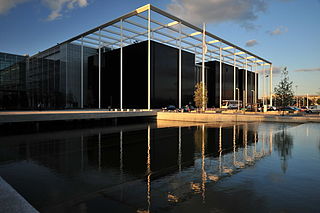
DR Byen is the headquarters of the Danish Broadcasting Corporation, DR, located in Copenhagen, Denmark, in the northwestern part of Amager. The first employees moved into DR Byen in 2006 and 2007, but the entire building, including the Koncerthuset Concert Hall, was not completed until 2010. The construction industry's enormous budget overruns have been widely discussed, and were also one of the main reasons of former CEO Kenneth Plummer's announcement on March 13, 2007, that 521 positions would be cut, and that 300 employees would be dismissed. DR Byen replaced Radiohuset in Frederiksberg and TV-Byen in Søborg.
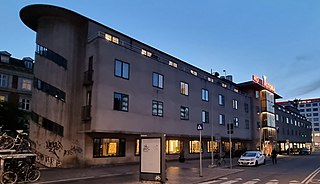
Hotel Astoria is a design hotel located next to the Central Station in Copenhagen, Denmark. The building is an early example of Functionalist architecture in Denmark. The hotel consists of a long slender wing forming a barrier between the urban space in front of the main entrance to the Central Station, which partly opens to the underground rail lines, and Reventlowsgade, the street on the Vesterbro side of the station. An example of architecture parlante, the building is intended to resemble a steam locomotive, It was listed in the Danish registry of protected buildings and places in 2019.

Sønder Boulevard is a boulevard in the Vesterbro district of Copenhagen, Denmark, whose broad central reserve has been turned into a linear park with various facilities for sports and other activities. It runs from Halmtorvet next to Copenhagen Central Station in the north east to the Carlsberg district in the southwest.
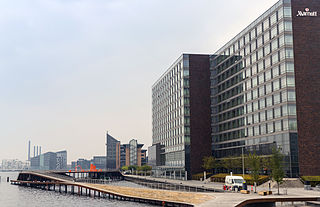
Kalvebod Brygge is a waterfront area in the Vesterbro district of Copenhagen, Denmark. The name also refers to a section of the Ring 2 ring road which follows the waterfront from Langebro in the north to the H. C. Ørsted Power Station in the south. The area is dominated by office buildings, Tivoli Conference Center, several hotels and the shopping centre Fisketorvet.

Østerfælled Torv is a mixed-use development surrounding a public space by the same name in the former grounds of Østerfælled Barracks in the Østerbro district of Copenhagen, Denmark. It is a result of a redevelopment of the site in the 1990s which preserved many of the old buildings, now used for retail and commercial space as well as cultural facilities, combining them with new apartment buildings.
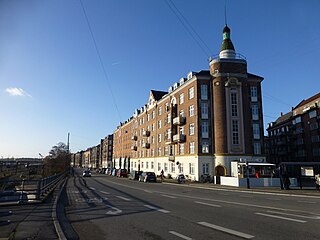
Ingerslevsgade is a street in the Vesterbro district of Copenhagen, Denmark. It begins on the rear side of Copenhagen Central Station and follows the northwest side of the railway tracks to Enghave station. It also passes the Dybbølsbro station where Dybbøl Bridge connects it to Kalvebod Brygge and Havneholmen, Copenhagen on the other side of the railway tracks. The street is named after the politician Hans Peter Ingerslev, who was involved in the construction of the Free Port of Copenhagen.

TV-Byen is the former headquarters of national Danish broadcaster DR, located in Gladsaxe, approximately 9 kilometres northwest of central Copenhagen, Denmark. The 207,000 m2 site has been redeveloped with a mixture of offices, housing and retail after DR inaugurated their new headquarters, DR Byen in 2007.

Øksnehallen is an exhibition space located on Halmtorvet in the Vesterbro district of Copenhagen, Denmark. The building is a former market hall, part of the Brown Meat District.
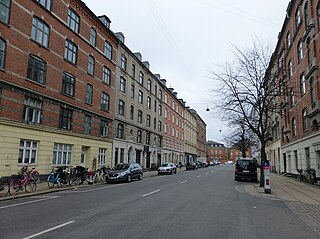
Århusgade is a street in the Østerbro district of Copenhagen, Denmark. It extends east from Østerbrogade and passes under the railway just before entering the southernmost part of Nordhavn which is known as the Århusgade neighbourhood after it. The street has many cafés and small shops. The street is named after the City of Aarhus, the second largest city in Denmark.
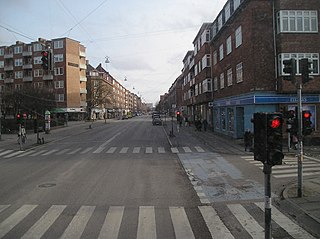
Peter Bangs Vej is a 2.2 km long street in Frederiksberg, a city in the Copenhagen area on the island of Zealand, Denmark. The direct continuation of Smallegade, it initially runs west, from Nordre Fasanvej, but then turns south along the east side of Damhus Lake to meet Roskildevej. There is a large sports complex on the south end of the street with the football club F.C. Copenhagen's training facilities as well as the multi-purpose venue K.B. Hallen.

Ofelia Plads is a public space situated on the Kvæsthus Pier next to the Royal Danish Playhouse on the harbourfront in Copenhagen, Denmark. It is owned by the Ministry of Culture and Jeudan and is used as an open-air venue by the Royal Danish Theatre. It was completed in 2016 to design by Lundgaard & Tranberg and is located on top of an underground parking facility with room for 500 cars.

DGI-Huset or DGI Huset Aarhus is a sports center located in Aarhus, Denmark. Parts of the buildings are historic, built in 1910 as part of the Aarhus Central Workshops for the Danish national railway company DSB. In 1990, DSB closed and sold their repair facilities to Aarhus Municipality and in 1997 the sports organization of DGI bought the building. An extensive renovation and construction project was completed on 11 October 2003, including new extensions. The buildings now serves as the primary facility for the sports organization Danske Gymnastik- & Idrætsforeninger in Aarhus, featuring a number of sports facilities, conference rooms. It is also home to some local sports clubs. The organization DGI-Århusegnen, the local chapter of the national organization DGI, took initiative to establish the sports center in the building.

Tietgensgade is a street in central Copenhagen, Denmark. It runs from H. C. Andersens Boulevard in the northeast to Kvægtorvgade at the Meat-Packing District in the southwest, linking Stormgade in the city centre with Ingerslevsgade and Halmtorvet/Sønder Boulevard in Vesterbro. The street follows the rear side of Tivoli Gardens and Copenhagen Central Station. The viaduct that carries it across the railway tracks at the central station is known as Tietgensbro. A series of staircases and lifts provides direct access from the viaduct to the station platforms.

Reventlowsgade is a street in the Vesterbro district of Copenhagen, Denmark, which follows the "Vesterbro side" of Copenhagen Central Station, between Vesterbrogade to the northwest and Tietgensgade to the southeast. One of the entrances to the Copenhagen Central Station City Circle Line metro station is located in the street. The street was refurbished in conjunction with the opening of the metro station, with new trees, seating and facilities for bicycle parking.





















